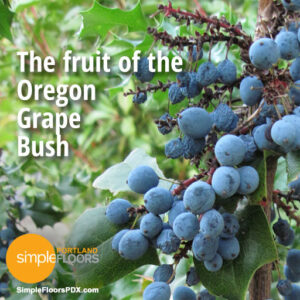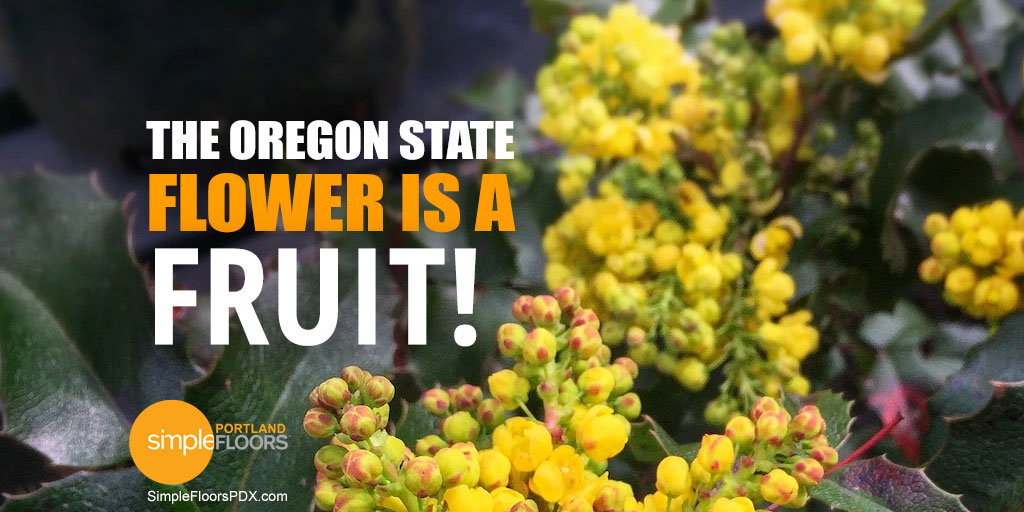Ever since Oregon became a state in 1859, Oregonians worked to find consensus on the state flower, state bird, state nut, and state motto. In 1890, the Oregon Horticultural Society formed a committee to nominate the state flower. Many flowers were nominated including the madrone, wake-robin, bearded gaillardia, and the Washington lily. On July 18, 1892, the Oregon Horticultural Society voted the Oregon grape as the state flower.
But our story of the Oregon state flower doesn’t end there.
To make the Oregon grape the official state flower, it needed to be approved by the legislature. That meant they needed people to petition the government to adopt the resolution. The Oregon Federation of Women’s Clubs took up the challenge and rallied its troops.
And on January 30, 1899, the Oregon state legislators heard the petition and voted to approve the Oregon Grape (Mahonia aquifolium) as the Oregon state flower.
The truth is that the Oregon Grape isn’t a true grapevine at all. It’s related to the holly family. The small yellow flower blossoms grow in grape-like clusters blooming in early Summer. In the fall, they turn into dark, purple-black berries that are edible. You may want to bring in some of the flowers at their peak as they’re very pleasantly fragrant.
What Is The Oregon State Flower Like?
The Oregon Grape is a low-growing shrub that is found primarily around the coast. It’s not a vine, like a real grape. As a perennial, the Oregon Grape’s leaves survive year-round and look kind of like the leaves on a holly bush. To avoid confusion, some people refer to the bush as the Oregon holly-grape. The sweetly scented yellow flowers look like clusters of grapes.
The tall Oregon Grape can grow up to six feet tall. Some people train it for a lovely ornamental landscape.
Then there’s the dull Oregon Grape which is shorter growing to be around three to four feet high.
 Both varieties have rhizomatous roots which allow them to spread out underground. You can buy plants at your local gardening center or nursery. The Oregon Grape grows well in our Portland microclimates. But the true Oregon Grape is the larger shrub and grows best in transition zones at a forest’s edge. The Mahonia nervosa is more like a barberry plant growing closer to the ground. It’s happiest in our dense evergreen forests.
Both varieties have rhizomatous roots which allow them to spread out underground. You can buy plants at your local gardening center or nursery. The Oregon Grape grows well in our Portland microclimates. But the true Oregon Grape is the larger shrub and grows best in transition zones at a forest’s edge. The Mahonia nervosa is more like a barberry plant growing closer to the ground. It’s happiest in our dense evergreen forests.
Meriwether Lewis (of Lewis and Clark fame) documented the Oregon Grape growing along the Columbia River. He called them “mountain holley” in his journal in 1806. You can also find it growing along the Willamette River around Salem.
One more piece of trivia. “Aquifolium” refers to the shiny, wet, waxy leaves on the plant.
Can You Eat Oregon Grape Fruit?
 You can harvest the deep blue berries when they’re ripe which is about from July to about September depending upon how warm the season is. The fruit is a bit tart when raw. It becomes sweeter when cooked. And it makes wonderful preserves and jellies. They are also used to make wines and pies. Just make sure you strain out the large seeds in the berries.
You can harvest the deep blue berries when they’re ripe which is about from July to about September depending upon how warm the season is. The fruit is a bit tart when raw. It becomes sweeter when cooked. And it makes wonderful preserves and jellies. They are also used to make wines and pies. Just make sure you strain out the large seeds in the berries.
The First Nation Tribes would also dry the berries like raisins which last about one to two years. They would also boil the Oregon Grape into tonics, teas, and medicines.
The Oregon Grape berry is also used for purple dyes, and the root is used to make yellow dyes.
The Medicinal Properties of Oregon Grape
You knew the Oregon Grape had to have a lot of uses, right? It deserves its title of the Oregon State Flower. European settlers assumed that it was a Barberry and made medicines and teas around that knowledge. So it is not a big surprise to learn that the Oregon Grape and European barberries are related.
The root was often used to make medicines to cure GERD, stomach ulcers, cleanse the bowels, and more. Some apply a paste of the bark to the skin for psoriasis as well as a disinfectant.
The bitter compounds in the Oregon Grape stimulate the release of bile from the liver and gallbladder. This helps your body detoxify and purge.
You can find Oregon Grape bark extract creams today if you’re so inclined to try them on dry cracked skin. The berberine family of plants has strong antimicrobial properties. So you can also use it on slow-healing wounds and gum problems. The Oregon Grape is also related to goldenseal and can be used as a liver stimulant and blood tonic.
Obviously, you need to be careful and shouldn’t randomly eat the berries or roots if you’re pregnant or lactating. Also, consult experts to ensure there are no negative reactions to other pharmaceutical drugs you may be taking.
The Mythology of the Oregon Grape
The First Nation Tribes believed the Oregon Grape was a protector. Three branches of the Oregon Grape placed on your threshold would keep enemies at bay.
Fun Facts About the Oregon Grape
- It’s also considered an evergreen shrub.
- The leaves alternate consisting of 3 to 4 pairs and one odd leaf.
- The berries feed a wide variety of local wildlife including robins, juncos, towhees, and sparrows. Small foxes and raccoons also love dining on the berries.
So let’s honor our amazing state flower. How many of the other states have flowers that are protectors, and can be used in many different medicinal methods? Plus, they’re beautiful and can be used in landscaping providing greenery year-round.
We Oregonians do things our way even if our state flower is a fruit.
And just in case you were curious, in 2005, the legislature designated the pear (Pyrus communis) as the official state fruit.











